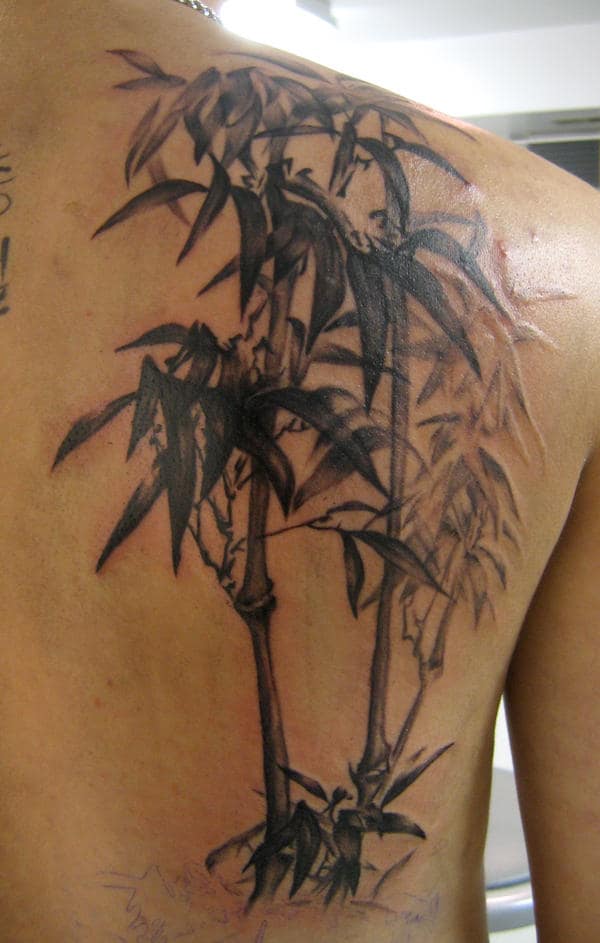
02 Oct The Art of Bamboo Tattooing: A Timeless Tradition
Introduction
In the world of body art, there exists a tradition that predates the modern tattoo machine and resonates with the essence of craftsmanship, culture, and spirituality. The art of bamboo tattooing, also known as “Sak Yant” in Thailand and “Tebori” in Japan, is a practice that has been passed down through generations for centuries. This ancient form of tattooing has a unique charm and a profound connection to cultural and spiritual significance. In this article, we will delve into the rich history, techniques, and symbolism of bamboo tattooing, highlighting the enduring allure of this timeless tradition.

A Historical Perspective
Bamboo tattooing traces its roots to Southeast Asia, particularly in Thailand and Cambodia, where it is deeply ingrained in the local culture and spirituality. The art of Sak Yant, meaning “magic tattoo” in Thai, is believed to have originated over a thousand years ago, drawing inspiration from ancient Hindu and Buddhist scriptures. These tattoos were initially reserved for monks and warriors, offering protection, blessings, and spiritual guidance.
The Tradition Lives On
Despite the modernization of tattoo techniques, bamboo tattooing has remained a cherished tradition in Southeast Asia. It is regarded as a rite of passage, a means of protection, and a channel for spiritual connection. The art has also gained popularity among travelers seeking a unique and meaningful souvenir of their journey.
The Bamboo Tattooing Process
Unlike the electric tattoo machine, which uses needles to puncture the skin, bamboo tattooing employs a handcrafted tool made of bamboo and steel needles. The process involves the following steps:
- Design Selection: Clients often choose designs from a repertoire of sacred symbols and intricate patterns. These designs vary in meaning and purpose, with each carrying its unique significance.
- Needle Preparation: The artist carefully attaches single-use sterilized needles to the bamboo stick. The needles are dipped in ink, usually made from a mixture of charcoal and water, throughout the tattooing process.
- Hand-Tapping Technique: With precision and skill, the artist taps the bamboo tool repeatedly into the skin. The tattoo is created by the controlled depth and frequency of these taps. This method requires a delicate touch and years of experience to master.
- Healing Rituals: After the tattoo is complete, the artist performs rituals to imbue it with spiritual significance. This often includes blessings and incantations for protection and good fortune.
Symbolism and Meaning
The designs used in bamboo tattooing are deeply symbolic and often serve as a representation of the wearer’s beliefs, values, and aspirations. Some common symbols include:
- Tigers: Symbolizing strength, courage, and protection.
- Buddhas: Signifying enlightenment and spiritual growth.
- Thai script: Containing sacred mantras and blessings.
- Animals: Representing various attributes such as loyalty or agility.
It is essential to understand that the meanings of these tattoos can vary depending on the specific design, its placement on the body, and the intentions of the wearer. This makes each bamboo tattoo a unique and deeply personal expression of identity and spirituality.
The Spiritual Connection
One of the most captivating aspects of bamboo tattooing is its deep spiritual connection. The process often involves a spiritual interaction between the artist and the recipient, as the tattoos are believed to carry protective and transformative powers. Many people who receive bamboo tattoos do so as an act of devotion or to seek guidance and protection from the spiritual world.
The Healing Aspect
Beyond the spiritual connection, bamboo tattooing is also regarded as a form of therapy. The rhythmic tapping of the bamboo needles can induce a state of relaxation and meditation in both the artist and the recipient. Some individuals find that the experience of receiving a bamboo tattoo can be healing, both physically and emotionally.
Preserving the Tradition
In recent years, the art of bamboo tattooing has gained recognition beyond its Southeast Asian roots. Tattoo artists from around the world are learning the techniques and incorporating them into their practice. However, this expansion has also raised questions about cultural appropriation and authenticity. It is crucial to approach bamboo tattooing with respect for its origins and traditions.
Conclusion
The art of bamboo tattooing is a living testament to the enduring power of ancient traditions and the deep connection between body, mind, and spirit. Its rich history, intricate techniques, and profound symbolism make it a unique and meaningful form of body art. Whether you are drawn to bamboo tattooing for its spiritual significance, cultural roots, or simply its aesthetic appeal, one thing is certain: it is an art form that continues to captivate and inspire, bridging the gap between the past and the present.



No Comments